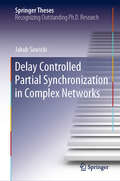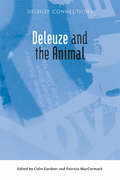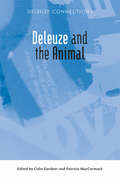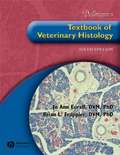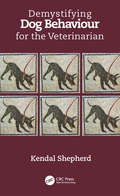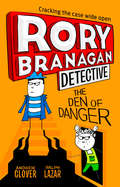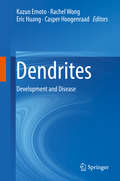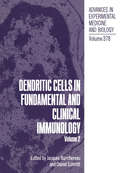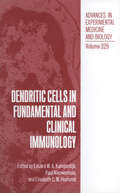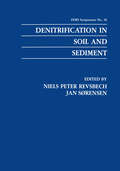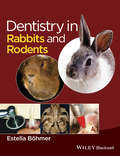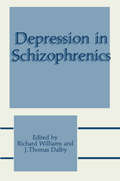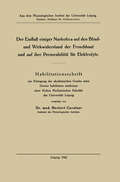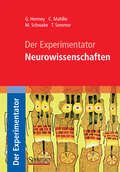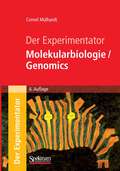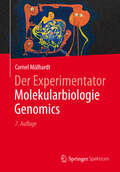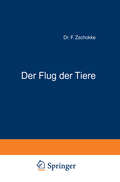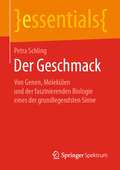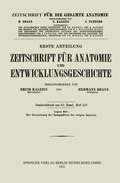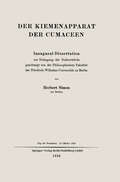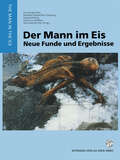- Table View
- List View
Delay Controlled Partial Synchronization in Complex Networks (Springer Theses)
by Jakub SawickiThe focus of this thesis are synchronization phenomena in networks and their intrinsic control through time delay, which is ubiquitous in real-world systems ranging from physics and acoustics to neuroscience and engineering. We encounter synchronization everywhere and it can be either a helpful or a detrimental mechanism. In the first part, after a survey of complex nonlinear systems and networks, we show that a seemingly simple system of two organ pipes gives birth to complex bifurcation and synchronization scenarios. Going from a 2-oscillator system to a ring of oscillators, we encounter the intriguing phenomenon of chimera states which are partial synchrony patterns with coexisting domains of synchronized and desynchronized dynamics. For more than a decade scientist have tried to solve the puzzle of this spontaneous symmetry-breaking emerging in networks of identical elements. We provide an analysis of initial conditions and extend our model by the addition of time delay and fractal connectivities. In the second part, we investigate partial synchronization patterns in a neuronal network and explain dynamical asymmetry arising from the hemispheric structure of the human brain. A particular focus is on the novel scenario of partial relay synchronization in multiplex networks. Such networks allow for synchronization of the coherent domains of chimera states via a remote layer, whereas the incoherent domains remain desynchronized. The theoretical framework is demonstrated with different generic models.
Deleuze and the Animal (Deleuze Connections)
by Colin Gardner Patricia MacCormackBecoming-animal is a key concept for Deleuze and Guattari; the ambiguous idea of the animal as human and nonhuman life infiltrates all of Deleuze’s work. These 16 essays apply Deleuze’s work to analysing television, film, music, art, drunkenness, mourning, virtual technology, protest, activism, animal rights and abolition. Each chapter questions the premise of the animal and critiques the centrality of the human. This collection creates new questions about what the age of the Anthropocene means by ‘animal’ and analyses and explores examples of the unclear boundaries between human and animal.
Deleuze and the Animal (Deleuze Connections)
by Colin Gardner Patricia MacCormackBecoming-animal is a key concept for Deleuze and Guattari; the ambiguous idea of the animal as human and nonhuman life infiltrates all of Deleuze’s work. These 16 essays apply Deleuze’s work to analysing television, film, music, art, drunkenness, mourning, virtual technology, protest, activism, animal rights and abolition. Each chapter questions the premise of the animal and critiques the centrality of the human. This collection creates new questions about what the age of the Anthropocene means by ‘animal’ and analyses and explores examples of the unclear boundaries between human and animal.
Dellmann's Textbook of Veterinary Histology
by Jo Ann Eurell Brian L. FrappierThe leading veterinary histology text returns with a fully updated sixth edition. Written in a concise, easy-to-understand that's a pleasure to read, this new edition continues the student-friendly tradition originated by Dr. Dellman, presenting the basics of histology including cytology and microscopic anatomy. The Sixth Edition focuses on the most current knowledge of cell, tissue and organ structure and function. All information has been fully revised and updated by the authors, both experts in their fields. Written with first year veterinary students in mind, it is also an important resource for veterinarians, graduate students, and others who require information on animal tissue structure and function. Highlights of the Sixth Edition include: New images and line drawings have been added to enhance the student's understanding of concepts. Two-page insert contains full-color histology images. Comprehensive listings of suggested readings at the end of each chapter encourage further study. The text is organized by body region, allowing the presentation to emphasize comparative species information so students can better appreciate how species differ in regard to key structures. Whether you're a veterinary student or practicing professional, you should have this classic histology reference as part of your working library.
Dellmann's Textbook of Veterinary Histology
by Jo Ann Eurell Brian L. FrappierThe leading veterinary histology text returns with a fully updated sixth edition. Written in a concise, easy-to-understand that's a pleasure to read, this new edition continues the student-friendly tradition originated by Dr. Dellman, presenting the basics of histology including cytology and microscopic anatomy. The Sixth Edition focuses on the most current knowledge of cell, tissue and organ structure and function. All information has been fully revised and updated by the authors, both experts in their fields. Written with first year veterinary students in mind, it is also an important resource for veterinarians, graduate students, and others who require information on animal tissue structure and function. Highlights of the Sixth Edition include: New images and line drawings have been added to enhance the student's understanding of concepts. Two-page insert contains full-color histology images. Comprehensive listings of suggested readings at the end of each chapter encourage further study. The text is organized by body region, allowing the presentation to emphasize comparative species information so students can better appreciate how species differ in regard to key structures. Whether you're a veterinary student or practicing professional, you should have this classic histology reference as part of your working library.
Demystifying Dog Behaviour for the Veterinarian
by Kendal ShepherdThe behaviour textbook that's been missing! - Dr Mandy Roshier, University of Nottingham, School of Veterinary Medicine and Science, UK This practical guide for busy veterinarians demystifies the apparently complex nature of canine behaviour while simultaneously emphasising its importance. Authored by acclaimed veterinary behaviour consultant Kendal Shepherd, the book provides practical knowledge of dog behaviour and an understanding of how to talk about it with clients. Shepherd shows how this can enhance the relationship between owner and pet and between dog and environment, including the vet surgery, as well as improve the vet’s own sense of fulfilment and enjoyment of practice. From a discussion on the true nature of obedience to stressing the importance of behavioural indicators when assessing pain and mental welfare and finally by reminding vets of their obligations under Dangerous Dogs legislation, the emphasis is on the prevention of aggression throughout. Packed with anecdotes drawn from real-life cases, easy to read and understand, the principles explained can be effortlessly assimilated into the average consultation without the need for lengthy report-writing.
Demystifying Dog Behaviour for the Veterinarian
by Kendal ShepherdThe behaviour textbook that's been missing! - Dr Mandy Roshier, University of Nottingham, School of Veterinary Medicine and Science, UK This practical guide for busy veterinarians demystifies the apparently complex nature of canine behaviour while simultaneously emphasising its importance. Authored by acclaimed veterinary behaviour consultant Kendal Shepherd, the book provides practical knowledge of dog behaviour and an understanding of how to talk about it with clients. Shepherd shows how this can enhance the relationship between owner and pet and between dog and environment, including the vet surgery, as well as improve the vet’s own sense of fulfilment and enjoyment of practice. From a discussion on the true nature of obedience to stressing the importance of behavioural indicators when assessing pain and mental welfare and finally by reminding vets of their obligations under Dangerous Dogs legislation, the emphasis is on the prevention of aggression throughout. Packed with anecdotes drawn from real-life cases, easy to read and understand, the principles explained can be effortlessly assimilated into the average consultation without the need for lengthy report-writing.
The Den of Danger (Rory Branagan (Detective) #6)
by Andrew CloverMeet RORY BRANAGAN – he eats bad guys for breakfast. Well, not ACTUALLY. But he IS the best detective in town. Sixth in a hilarious comedy-crime series for readers of 8+.
Dendrites: Development and Disease
by Kazuo Emoto Rachel Wong Eric Huang Casper HoogenraadStudies in human patients and animal models of disease suggest a strong correlation between defects in dendrite development and common neurological disorders such as autism. Much of this book is thus dedicated toward highlighting recent advances in our understanding of the cellular and molecular mechanisms that regulate the development and maintenance of dendrites, a crucial component of neurons. The book begins by presenting the current state of knowledge on the building blocks or cell biology of dendrites. Mechanisms that sculpt the stereotypic architecture of dendritic arbors and shape their connectivity are also discussed, along with recent work describing how dendritic organization and connectivity are perturbed in disease. A unique aspect of the book is its exploration of diverse neuronal cell types across vertebrates and invertebrates, allowing a comparison of mechanisms across distinct circuits and species. The book comprises six parts, which cover the major advances in the field: Part 1, Introduction; Part 2, Basic Biology of Dendrites; Part 3, Patterning Dendritic Architecture of Neurons and Their Populations; Part 4, Cellular and Molecular Control of Dendrite Development and Maintenance; Part 5, Synapse Formation onto Dendrites; and Part 6, Dendrites in Disease. The book offers an excellent point of entry for students interested in neuroscience, as well as for clinicians.
Dendritic Cells in Fundamental and Clinical Immunology: Volume 2 (Advances in Experimental Medicine and Biology #378)
by Jacques Banchereau Daniel SchmittThese Proceedings contain the contributions of the partIcIpants of the Third International Symposium on Dendritic Cells that was held in Annecy, France, from June 19 to June 24, 1994. This symposium represented a follow-up of the first and second international symposia that were held in Japan in 1990 and in the Netherlands in 1992. Dendritic cells are antigen-presenting cells, and are found in all tissues and organs of the body. They can be classified into: (1) interstitial dendritic cells of the heart, kidney, gut, and lung;(2) Langerhans cells in the skin and mucous membranes; (3) interdigitating dendritic cells in the thymic medulla and secondary lymphoid tissue; and (4) blood dendritic cells and lymph dendritic cells (veiled cells). Although dendritic cells in each of these compartments are all CD45+ leukocytes that arise from the bone marrow, they may exhibit differences that relate to maturation state and microenvironment. Dendritic cells are specialized antigen-presenting cells for T lymphocytes: they process and present antigens efficiently in situ, and stimulate responses from naive and memory T cells in the paracortical area of secondary lymphoid organs. Recent evidence also demonstrates their role in induction of tolerance. By contrast, the primary and secondary B-cell follicles contain follicular dendritic cells that trap and retain intact antigen as immune complexes for long periods of time. The origin of follicular dendritic cells is not clear, but most investigators believe that these cells are not leukocytes.
Dendritic Cells in Fundamental and Clinical Immunology (Advances in Experimental Medicine and Biology #329)
by Paul Nieuwenhuis Eduard W. A. Kamperdijk Elizabeth C. M. HoefsmitThese Proceedings contain the contributions of the participants of the Second International Symposium on Dendritic Cells that was held from the 1st to 25th of June 1992 in Amsterdam, the Netherlands. The First International Symposium on Dendritic Cells was organized as a Satellite symposium at the occasion of the 30th anniversary of the Japanese Reticuloendothelial Society by Dr. Y. Imai in Yamagata (Japan), in 1990. It was entitled "Dendritic Cells in Lymphoid Tissues," and focused primarily on the Interdigitating Cells (IDC), Epidermal Langerhans cells (LC) and Follicular Dendritic Cells (FDC) , from the point of view of human pathology. However, the concept of Dendritic Cell System, comprising the bone marrow derived IDC and LC but not the FDC, was based on animal experiments and mainly on in vitro experiments on isolated cells. In a report from the Reticuloendothelial Society Committee on Nomenclature in 1982, Tew, Thorbecke and Steinman had already characterized these different types of DC, but the gap between in vivo and in vitro function remained. In Amsterdam, the Symposium focused on the Role of Dendritic Cells in Fundamental and Clinical Immunology. First, recent developments in molecular biology of antigen presentation and cell biological aspects of signal transduction were discussed, in relation to the potential of DC to stimulate lymphocytes and to trigger their in vitro differentiation.
Denitrification in Soil and Sediment (F.E.M.S. Symposium Series #56)
by Niels Peter Revsbech Jan SørensenThe formation of atmospheric nitrogen gas by denitrifying bacteria may represent a significant nutrient sink in natural ecosystems. The rate of denitrification has often been difficult to measure in situ, however, and new methodologies should stimulate research on distribution of activity in space and time. The load of fertilizer nitrogen in modem agriculture has led to increasing nutrient reservoirs in recipient subsoils, aquifers, inland waters and coastal seas. By its conversion of nitrate to atmospheric nitrogen, bacterial denitrification is the only biological process to potentially reduce the impact of increasing nutrient loadings by fertilizer nitrogen in the environment. As part of a scientific program set up by the Danish Ministry of Environment to study environment cycling of nitrogen, phosphorous and organic matter (NPO program) in the light of agricultural, domestic and industrial activities, a symposium on DENITRIFICATION IN SOIL AND SEDIMENT was held at the University of Aarhus, Denmark from 6-9 June 19i\9. On the basis of lectures given at the symposium, this book contains a number of invited contributions on the regulation of denitrification activity (control of enzyme synthesis and activity) and measurement of in situ rates of denitrification in terrestrial and aquatic environments (control factors, diel and seasonal variations, etc). Emphasis has been placed on including the recent improvements in methodologies and current understanding of process regulation, however the book also contains examples of integrated research on the significance of denitrification in environmental nutrient cycling.
Dentistry in Rabbits and Rodents
by Estella BöhmerDentistry in Rabbits and Rodents is a practical guide aimed at helping clinicians successfully diagnose and treat dental problems in rabbits and rodents within their own surgeries. With over two-thirds of small mammals presenting with tooth related problems, there is great potential to enhance the treatment offered to the owners of these species. Focusing on innovative diagnostics using normal radiographic machines as well as specific positioning techniques, radiographs are presented with reference lines and detailed annotations. Richly illustrated with high quality photographs, pathological findings are described before selection of appropriate therapy and treatment is discussed. Key features include: Covers the dental anatomy and physiology of all small mammal species commonly kept as pets. Intraoral radiography and innovative positioning for imaging the guinea pig and chinchilla dentitions are described, enabling the practitioner to visualize each tooth in detail. Once a diagnosis has been reached, selection of different treatments and the advantages and disadvantages of each surgical technique are discussed. Offers helpful directives for approaching and treating dental disease without the need for referral to a specialist or the use of expensive equipment.
Dentistry in Rabbits and Rodents
by Estella BöhmerDentistry in Rabbits and Rodents is a practical guide aimed at helping clinicians successfully diagnose and treat dental problems in rabbits and rodents within their own surgeries. With over two-thirds of small mammals presenting with tooth related problems, there is great potential to enhance the treatment offered to the owners of these species. Focusing on innovative diagnostics using normal radiographic machines as well as specific positioning techniques, radiographs are presented with reference lines and detailed annotations. Richly illustrated with high quality photographs, pathological findings are described before selection of appropriate therapy and treatment is discussed. Key features include: Covers the dental anatomy and physiology of all small mammal species commonly kept as pets. Intraoral radiography and innovative positioning for imaging the guinea pig and chinchilla dentitions are described, enabling the practitioner to visualize each tooth in detail. Once a diagnosis has been reached, selection of different treatments and the advantages and disadvantages of each surgical technique are discussed. Offers helpful directives for approaching and treating dental disease without the need for referral to a specialist or the use of expensive equipment.
Depression in Schizophrenics
by Richard Williams J. Thomas DalbyThe chapters of this volume were originally presented at a symposium on "Depression in Schizophrenics" held at the University of Calgary, Health Sciences Centre on July 06 and 07, 1988. It was the intent of the organizers to draw together leading international researchers to address, in a comprehensive fashion, the persisting problem of depression in schizophrenic individuals. As many of the authors point out, depression was clearly identified as a central problem in schizophrenia by the pioneers of psychiatry. Their wisdom and clinical acumen was lost for a time to be only recently re discovered. Their insights must now be integrated with modern taxonomic systems, evolving etiological models and methods of assessment. With increased recognition of the problem of depression in this population we must also examine appropriate methods of ameliorating the suffering of those afflicted. The conference was divided into sections (theoretical aspects, phenomenology, suicide and treatment) and the chairmen of these sections have given brief introductions. Necessary overlap of topics and methods provided a convergent and validating examination of empirical results which may serve to direct continuing studies. As well we hope that thoughtful review may directly influence clinical practice and thereby improve the quality of life for schizophrenic patients.
Der anatomische Wortschatz: unter Mitberücksichtigung der Histologie und der Embryologie für Studierende, Ärzte und Tierärzte
by G. KrügerDer Einfluß einiger Narkotica auf den Blind- und Wirkwiderstand der Froschhaut und auf ihre Permeabilität für Elektrolyte: Habilitationsschrift
by Herbert GerstnerDieser Buchtitel ist Teil des Digitalisierungsprojekts Springer Book Archives mit Publikationen, die seit den Anfängen des Verlags von 1842 erschienen sind. Der Verlag stellt mit diesem Archiv Quellen für die historische wie auch die disziplingeschichtliche Forschung zur Verfügung, die jeweils im historischen Kontext betrachtet werden müssen. Dieser Titel erschien in der Zeit vor 1945 und wird daher in seiner zeittypischen politisch-ideologischen Ausrichtung vom Verlag nicht beworben.
Der Experimentator: Neurowissenschaften (Experimentator)
by Guido Hermey Claudia Mahlke Michael Schwake Tobias SommerLieber EXPERIMENTATOR, dieser neue Band soll dem angehenden Neurowissenschaftler einen Überblick über Fragestellungen und Methoden der neurowissenschaftlichen Forschung geben. Deshalb beschreiben wir gut etablierte Standardmethoden und geben Einblicke in die aktuellen Trends und Entwicklungen, die die moderne neurowissenschaftliche Forschung vorantreiben. Der Fokus des Buches liegt auf der Erklärung von grundsätzlichen Mechanismen und Versuchsprinzipien. Zudem weist es auf viele „kleine“ Tricks des Laboralltags hin, die dem EXPERIMENTATOR das Leben erheblich erleichtern können. Inhaltlich haben wir uns auf die Analyse des Vertebratengehirns fokussiert, da es die Möglichkeit bietet, komplexe neuronale Vorgänge zu untersuchen, die z.B. für das Lernen, aber auch für die Analyse neuronaler Erkrankungen von Bedeutung sind. Methodisch spannen wir dabei den Bogen von molekularen, proteinbiochemischen, zellbiologischen und elektrophysiologischen Ansätzen, über die Etablierung transgener Mausmodelle und deren Analyse (z.B. in verhaltensbiologischen Studien) bis hin zu nicht-invasiven Imaging-Methoden, die zur Untersuchung des menschlichen Gehirns einsetzbar sind. Trotz der Komplexität des Inhalts ist das Buch in einem leicht verständlichen Ton geschrieben und richtet sich sowohl an Studenten und Doktoranden, als auch an technische Mitarbeiter und fachfremde Forscher.
Der Experimentator: Molekularbiologie / Genomics (Experimentator)
by Cornel MülhardtDieses überaus erfolgreiche Laborhandbuch präsentiert das Grundlagenwissen sowie Tipps und Tricks für den Umgang mit Nucleinsäuren. Es richtet sich an alle Experimentatoren, die molekularbiologische Versuche durchführen wollen und gern nachvollziehen möchten, was sich in ihrem Reaktionsgefäß abspielt. Das ganze Spektrum der üblichen molekularbiologischen Methoden wird vorgestellt, kommentiert und Alternativen aufgezeigt. Am Ende findet sich auch noch ein Kapitel zur Karriereplanung.
Der Experimentator Molekularbiologie / Genomics (Experimentator)
by Cornel MülhardtDieses Buch enthält das Grundlagenwissen sowie Tipps und Tricks für den Umgang mit Nucleinsäuren. Der Autor kennt Lust und Frust der täglichen Laborroutine ganz genau.Präparieren, Fällen, Konzentrieren und Reinigen von NucleinsäurenRestriktionsenzyme, Gele, BlottenPolymerase-KettenreaktionRNA-Isolierung, -TranskriptionKlonierung von DNA-FragmentenMarkierung von Sonden, Hybridisierung, Screening, SequenzierungMutagenese, In-vitro-Translation, transgene Mäuse, Transgenexpression, Gentherapie, GenomikDieses Buch richtet sich an alle Experimentatoren, die molekularbiologische Versuche durchführen wollen und gern nachvollziehen möchten, was sich in ihrem Reaktionsgefäß abspielt. Das ganze Spektrum der üblichen molekularbiologischen Methoden wird vorgestellt, kommentiert und Alternativen aufgezeigt.Der lockere Ton wendet sich gleichermaßen an Studenten wie an BTAs und Laboranten, aber auch der alte Hase wird hier und dort noch etwas Neues entdecken. Die 7. Auflage wurde überarbeitet und aktualisiert.
Der Flug der Tiere
by F. ZschokkeDieser Buchtitel ist Teil des Digitalisierungsprojekts Springer Book Archives mit Publikationen, die seit den Anfängen des Verlags von 1842 erschienen sind. Der Verlag stellt mit diesem Archiv Quellen für die historische wie auch die disziplingeschichtliche Forschung zur Verfügung, die jeweils im historischen Kontext betrachtet werden müssen. Dieser Titel erschien in der Zeit vor 1945 und wird daher in seiner zeittypischen politisch-ideologischen Ausrichtung vom Verlag nicht beworben.
Der Geschmack: Von Genen, Molekülen und der faszinierenden Biologie eines der grundlegendsten Sinne (essentials)
by Petra SchlingPetra Schling gibt in diesem essential einen Überblick über den aktuellen Stand der Forschung zum Thema Geschmack. Dabei betrachtet sie Geschmack als Sinneswahrnehmung, die uns erlaubt, essenzielle Nahrungsbestandteile von Giften zu unterscheiden. Was wir essen hängt nicht unwesentlich davon ab, wie es uns schmeckt. Aber wie schmecken wir eigentlich – und was überhaupt? Als Omnivoren (Allesfresser) besitzen wir Menschen eine relativ breite Palette an Geschmacks-Rezeptoren nicht nur im Mund, die uns wichtige Informationen über unsere Nahrung vermitteln. Außerhalb des Mundes dienen Geschmackssinneszellen unserer angeborenen Immunabwehr dazu, Bakterien, Würmer und andere Eindringlinge zu „schmecken“. Darauf können und sollten wir uns verlassen. Unser Geschmackssinn warnt uns vor Giften und unerwünschten Mitbewohnern und lässt sich nur sehr bedingt durch Süßstoffe, Bitterblocker oder ähnliche Tricks täuschen.
Der Grenzstrang des Sympathicus bei einigen Sauriern
by August HirtDieser Buchtitel ist Teil des Digitalisierungsprojekts Springer Book Archives mit Publikationen, die seit den Anfängen des Verlags von 1842 erschienen sind. Der Verlag stellt mit diesem Archiv Quellen für die historische wie auch die disziplingeschichtliche Forschung zur Verfügung, die jeweils im historischen Kontext betrachtet werden müssen. Dieser Titel erschien in der Zeit vor 1945 und wird daher in seiner zeittypischen politisch-ideologischen Ausrichtung vom Verlag nicht beworben.
Der Kiemenapparat der Cumaceen: Inaugural-Dissertation
by Herbert SimonDieser Buchtitel ist Teil des Digitalisierungsprojekts Springer Book Archives mit Publikationen, die seit den Anfängen des Verlags von 1842 erschienen sind. Der Verlag stellt mit diesem Archiv Quellen für die historische wie auch die disziplingeschichtliche Forschung zur Verfügung, die jeweils im historischen Kontext betrachtet werden müssen. Dieser Titel erschien in der Zeit vor 1945 und wird daher in seiner zeittypischen politisch-ideologischen Ausrichtung vom Verlag nicht beworben.
